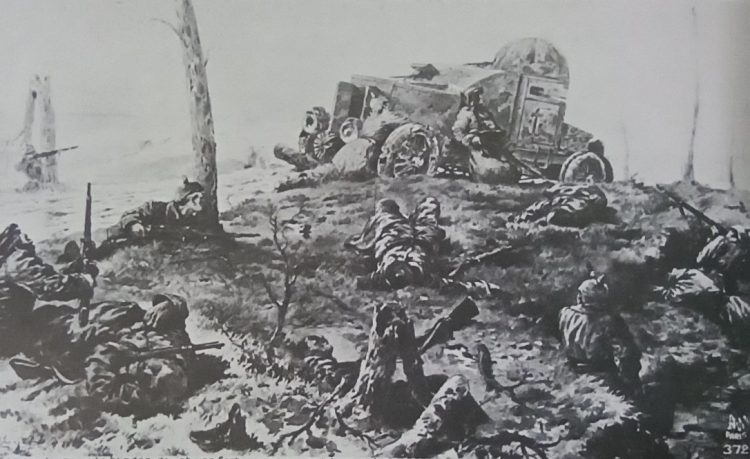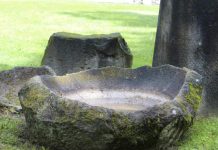The Armoured Cars and Tanks – Motor cars had made their appearance in the closing years of the nineteenth century. By the time that war broke out the efficiency and reliability of the internal combustion engine. On which these machines depended, had improved tremendously and it was only a matter of time before they were adapted for a military role.
Although some experimental armored cars had been produced in the first decade of the century. It was not until the war years when the situation created a demand that men turned their attention to their development and use. As a result, the armored car evolved, followed by the tank.
The first armored cars that appeared in 1914 were modified fast touring cars. Chassis of various manufacturers, including Wolseley, Talbot, Lanchester, Delauney-Belleville, and Rolls-Royce were requisitioned and hastily armored, armed, and strengthened to be fit for war. These cars were open-topped and armed with a machine gun which was able to fire over the side Armour.

Further development, based on bitter experience, was rapid and at first cars with completely enclosed turrets and all-around fire appeared on the roads in France. In the first month of hostilities, as the German Armies swept through Belgium, the armored cars of a Naval Brigade and a Royal Naval Air Service squadron were transported across the channel to help in the defense of Antwerp.
From their base in Dunkirk, these and others of the Belgian army were used for hitting and running attacks on the advancing enemy. While conditions were favorable the armored cars were in their element but as the armies dug in and ground conditions worsened. The cars were no longer able to fulfill their main role.
Few armored cars were used on the Western Front after the first winter and in early 1916 the cars of the RNAS squadron were transferred to other theaters of war where conditions remained suitable enough for their use. In Palestine, Egypt, Africa, and on the Eastern Front they continued in use only returning to France in 1918. When the trench line had been broken and warfare returned to the fluid state.

On the Western Front, it was their descendant, the tank, that took over part of their role in France. Due mainly to the efforts and foresight of such men as Colonel E.D. Swinton, Lieutcolonel Hankey, and Winston Churchill, then First Lord of the Admiralty, a Landship committee was formed in early 1915.
It was headed by the then Director of Naval Construction, Mr. Tennyson d’Eyncourt, and its main objectives were to explore the possibility of an armored car that would climb a vertical step of 4ft 6ins and cross a trench ten feet wide. The prototype ‘lands’ first appeared in September 1915 when the No. 1 Lincoln machine rumbled across Hatfield Park.
Its six-cylinder Daimler engine dragging it along at an incredible four miles per hour. A modified version of the tank, affectionately called ‘Little Willie’ underwent trials on September 19th but even while it was being put through its paces work had already begun on another machine built to a design by a Major Wilson and Sir William Tritton.

This tank underwent its official trials in January 1916 before Lord Kitchener, Mr. Lloyd George, Minister of Munitions, and other representatives of the War Office, at Burton Park, Lincoln. Christened ‘Big Willie’, ‘HMLS Centipede’ or, most aptly Mother, she was to provide the basis for the construction of all the tanks built in the war.
As a result of the trials, an order was made for forty machines, but this was subsequently increased to one hundred and fifty. To stifle curiosity and to maintain secrecy various ploys were tried to explain these large tarpaulined shapes that could be seen in railway yards and on trains as they were transported from the manufacturers in Lincoln and Birmingham to their training grounds in the grounds of Lord Iveagh’s Elvedon Estate near Thetford in Norfolk.
Someone had the bright idea of painting incomprehensible Russian characters on the side, which, for those who could translate, read, ‘With care, to Petrograd’. Discussions followed on what they should be called and of the many suggested three found most favor: ‘cisterns’, ‘reservoirs’ and ‘tanks.

When the decision was made the word “Tank’ took on a new and legendary meaning in the English language. Ten Marks of Tanks’ were developed in the years 1915-18. Some never existed beyond the prototype and others were completed after the armistice and were not used in war.
The Mark I Heavy Tank, the direct descendant of Mother’ was distinguished by two large rear steering wheels. One-hundred and fifty of these were supplied to the Army before being succeeded by the Marks II and III, also with steering wheels, but whose production numbers did not exceed fifty of each.
Mark IV appeared in April 1917 and was the first type without steering wheels although they had been removed from the earlier tanks when it was discovered that they formed a fragile and unnecessary appendage. Between April and December, over one thousand were made and supplied to the Army.
They were superseded in May 1918 by the more maneuverable Mark V. Each Mark was made in two types, a ‘male’ which was armed with two 6-pound naval guns and three machine guns, and a ‘female’ armed with five machine guns. Control of these monsters was a feat and of the crew of eight, four were required to steer and control the tank.
Moreover, communication, so essential for smooth running, was a problem in the dark and noisy confines and although hand signals and electric lights have experimented with a loud voice was essential. From the beginning of his offensive on the Somme in July, Field- Marshal Haig had been eager to use these new war machines. And by the beginning of September fifty tanks of ‘C’ and ‘D’ companies of the newly formed Heavy Section Machine Gun Corps were in France.
In the naive hope that they would break the deadlock, they were taken up to the front line, and with little time for preparation or training on the new ground, the crews were thrown into the fray. On 15th September, after an intensive three-day bombardment, thirty-two tanks (the remainder having broken down) advanced cautiously across no man’s land towards an unsuspecting enemy. They set their sights on the fortified villages of Courcelette, Marinpuich, and Flers and the trench systems running down to Bouleaux Wood near Combles.

Product You May Interested
- Cat Spraying No More – How to Stop Your Cat from Peeing Outside the Litter Box – Permanently.
- High-Quality Dog Training Course Featuring 21 Games to Improve your Dog’s intelligence & Behavior with Professional Dog Trainer.
- Flavor Pairing Ritual Supercharges Women’s Metabolisms
- The best Keto Diet Program
- Boost Your Energy, Immune System, Sexual Function, Strength & Athletic Performance
- Find Luxury & Designer Goods, Handbags & Clothes at or Below Wholesale
- Learn How To Build A 3d Solar Panel Converts Like Crazy, and Save a Lot of Money?
- Unlock your Hip Flexors, Gives you More Strength, Better Health, and All-Day Energy.
Read More
- Titanic History – A Miserable Night to Remember
- Legal and Ethical Issues in Salvaging Titanic Wreck
- Architecture and Applied Arts in Old Spain
- The Historical Rare Pictures of RMS Titanic Ship
- The Lost Treasure of Kelly’s Canyon, Idaho






